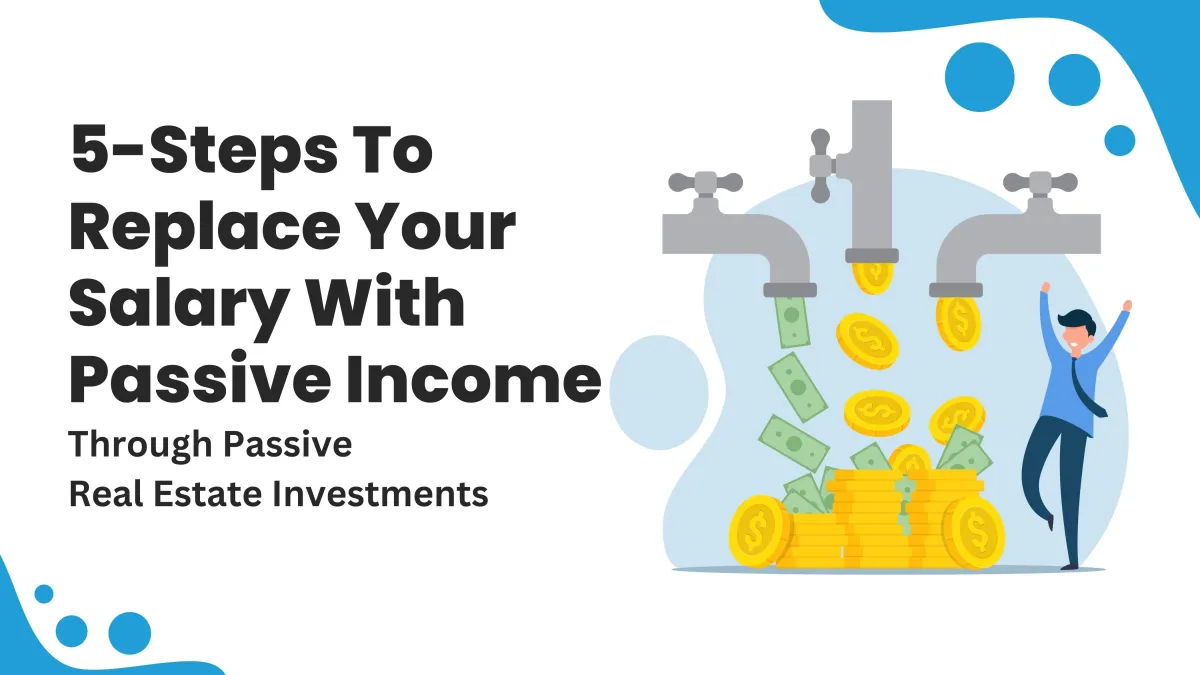Blog

5-Steps To Replace Your Salary With Passive Income
Imagine waking up every morning knowing that your bills are covered, your financial future is secure and your income isn't tied to your time. This was the goal I set out to achieve back when I got my start in real estate in 2020.
I began investing in triplexes, duplexes, and smaller properties with plans to scale up enough to replace my annual salary with passive income from the rents collected. But, there was one thing I didn't take into account... owning small rentals and managing them yourself is in no way passive. While the extra income was nice, I found myself spending about 2 hours per week per property dealing with emergency maintenance calls, tenant issues and the dreaded eviction process when renters stopped paying.
At this level, you're often not making enough profit after paying the mortgages and saving a percentage of the rental income for reserves to justify hiring a property manager. So, it's all on you.
Not long after this realization, I found a better way to invest in real estate that allowed me to build a portfolio and get all of the benefits, without the burden of being a landlord. Passive real estate investing in a real estate syndication offers a much better way to invest if you aren't looking to add to your already busy schedule. It offers a compelling avenue to generate steady passive income, while also building long-term wealth.
Here's the 5-step guide to replacing your salary with passive income and growing your wealth through passive real estate investing:
Step 1: Education On Passive Real Estate Investing
Passive real estate investing in a syndication is when multiple investors pool their money to invest in a real estate property, such as an apartment complex. Unlike active real estate investing, which requires you to manage properties directly, passive investments allow investors to leverage the expertise of others, like TR Capital Partners, while reaping all of the benefits rental real estate has to offer.
In a real estate syndication, there are primarily two parties. The general partners (GPs), who have the expertise to identify a property for acquisition, negotiate with the seller for the best deal, craft and execute a business plan, manage the property and eventually sell. The limited partners (LPs) on the other hand, are the passive investors who are looking to invest in real estate to grow their portfolio, without the burden of day-to-day operations.
Benefits of Passive Real Estate Investing:
· Steady income: Rental properties often provide consistent cash flow.
· Diversification: Real estate is a great asset to diversify your portfolio to hedge against inflation and stock market volatility, reducing your overall risk.
· Appreciation: Properties often increase in value over time through both natural and forced appreciation, offering a ton of upside potential when it comes time to sell.
· Tax Advantages: Depreciation deductions and other tax benefits keep more money in your pocket, enhancing overall returns.
Now, as with any investment there are risks and it's vital to take them into account to outline your own risk tolerance.
Risks to Consider:
· Potential for Market Volatility: While real estate isn't historically as volatile as the stock market, value can fluctuate based on market conditions.
· Operational Risk: Property management issues or unexpected expenses can impact returns if not planned for properly.
· Liquidity: Real estate is less liquid compared to stocks or bonds.
Having a basic understanding of these dynamics is crucial before starting your investment journey.
Here's a past webinar we hosted covering all of the basics.
Step 2: Assess Your Financial Situation
Before diving into real estate investing, you are going to want to conduct a thorough assessment of your financial status:
Evaluate Your Income and Expenses:
Prior to investing, you should have a strong grasp on your finances. Understand your current income streams, expenses, and savings. Determine how much you can comfortably allocate towards investments without compromising your financial stability.
Define Your Investment Goals:
Set very specific and clear objectives for your investments. Whether you are looking to generate passive income to cover living expenses, save for retirement or simply build wealth, having specific goals will guide you in making informed and strategic investment decisions.
Build an Emergency Fund:
Establish a strong emergency fund before you invest. Real estate is an illiquid asset, so having money saved is crucial when dealing with potential emergencies or unexpected expenses. The typical rule of thumb is to make sure this fund covers at least 3 to 6 months worth of living expenses to ensure you have a safety net in case of any unexpected financial setbacks.
Step 3: Build a Diversified Portfolio
Diversification is key to mitigating risk and maximizing returns in real estate investing.
As a passive investor, diversify your portfolio across different markets, asset types and projects to capture different market opportunities and mitigate your risk. Consider factors such as location, property types and market trends. A well-balanced portfolio can withstand market fluctuations and economic downturns more effectively.
On top of diversifying to further mitigate risk, you should be periodically reviewing your portfolio's performance and make adjustments as needed. Rebalancing your investments ensure that your portfolio remains aligned with your financial goals and risk tolerance over time.
Step 4: Due Diligence and Investment Selection
Prior to committing to any investment, you should conduct thorough due diligence. Evaluate the property fundamentals such as location, market demand and potential for appreciation. Analyze financial metrics including cash flow projections, cap rates and occupancy rates to gain a full understanding of the investment's viability.
This information strengthens your ability to mitigate risk and recognize any red flags such as high vacancy rates, deferred maintenance issues or unfavorable market conditions that can impact your returns. When looking into an opportunity, it's important to ask the GP team about how they plan to take all of these things into account to further protect and grow investor capital.
Step 5: Monitor and Reinvest
Even though, as a passive investor, the management and execution of the opportunity is a hands-off endeavor, you should always be actively monitoring the progress of your portfolio. Typically, the GP team will set up an investor portal that is the go-to place for investors to track everything going on throughout the life of the project. This will include distributions, total return to date, monthly updates and more. It is also important to stay on top of market trends and economic developments that may impact your investments in a negative or positive way. A good GP team will provide this information to you as new developments occur.
Next, reinvest the rental income or profits from property sales to compound your returns over time. Consistent monitoring and strategic reinvestment leads to sustainable passive income streams that will replace your salary over time. Make no mistake, this is not a get rich quick scheme, but with consistent investments, it has the ability to impact your wealth in a huge way. So, stay disciplined and patient, recognizing that financial independence through real estate investing is a journey that requires diligence and consistency
Whenever you're ready, there are 2 ways we can help you:
Join Our Investor Club + Get Your Free Passive Income Playbook: Join our Investor Club to get exclusive access to highly sought after multifamily real estate investment opportunities. For joining, we'll send you a FREE Passive Income Playbook to show you how our investor's are earning 16-22% annual returns without active management.
Investing w/ Your 401k/IRA: Join hundreds of other investors who invest in lucrative real estate investments with their old 401k/IRA's. Our webinar teaches you exactly how to invest in cash-flowing real estate and stop settling for average returns that typical retirement accounts offer. Go ahead and watch the replay for actionable tips on how investors are earning 16-20%+.
Investors Love Working With Us
Discover the power of multifamily investments and unlock your financial potential. Contact us today for exclusive opportunities in emerging markets
Let's have a conversation about how real estate syndications can contribute to achieving your financial objectives.
Investors Love Working With Us
Discover the power of multifamily investments and unlock your financial potential. Contact us today for exclusive opportunities in emerging markets
Let's have a conversation about how real estate syndications can contribute to achieving your financial objectives.






